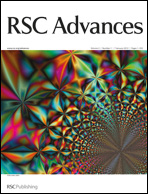Multifunctional nanoparticles for rapid bacterial capture, detection, and decontamination†
Abstract
Fluorescent magnetic nanoparticles (FMNPs) with a core–shell structure are synthesized through a one-pot chemical method followed by the bioconjugation of gentamycin (Gm). The average diameter of the FMNPs is estimated to be 65 ± 8 nm. The results of transmission electron microscopy (TEM), X-ray absorption near edge structure spectroscopy (XANES), and fluorospectrometry indicate that the FMNPs consist of a Fe3O4 core and a fluorescent silica (SiO2) shell. The FMNPs show typical superparamagnetic properties with a blocking temperature (TB) of 120 K. We demonstrate that gentamicin (Gm)-bioconjugated FMNPs can capture gram-negative bacteria, i.e. E. coli, (1 × 107 CFU mL−1 from 10 mL of solution) within 20 min. TEM micrographs clearly show that the Gm-FMNPs disrupt the cell wall of E. coli prior to the lysis of E. coli as the interaction time (t) increases; whereas FMNPs without Gm are inert towards E. coli. In addition, the Gm-FMNPs are able to detect diluted E. coli cells at a concentration as low as 1 × 103 CFU mL−1, which is revealed by a slight red-shift in fluorescent emissions from 517 nm to 528 nm along with a dramatic decrease in intensity. The Gm-conjugated FMNPs can be a multifunctional platform for simultaneous rapid capture, sensitive detection, and decontamination of bacteria.


 Please wait while we load your content...
Please wait while we load your content...